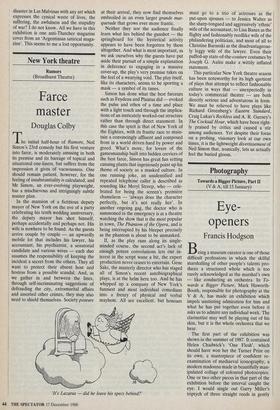New York theatre
Rumors (Broadhurst Theatre)
Farce master
Douglas Colby
The initial half-hour of Rumors, Neil Simon's 23rd comedy but his first venture into farce, is moderately amusing in both its premise and its barrage of topical and situational one-liners, but suffers from the impression it gives of vacuousness. One should remain patient, however, for the feeling of insubstantiality is calculated, and Mr Simon, an ever-evolving playwright, has a mischievous and intriguingly subtle master plan.
In the mansion of a fictitious deputy mayor of New York on the eve of a party celebrating his tenth wedding anniversary, the deputy mayor has shot himself, perhaps accidentally and perhaps not. His wife is nowhere to be found. As the guests arrive couple by couple — an upwardly mobile lot that includes his lawyer, his accountant, his psychiatrist, a senatorial candidate and various wives — each duo assumes the responsibility of keeping the incident a secret from the others. They all want to protect their absent host and hostess from a possible scandal. And, as we gather in and between the lines, through self-incriminating suggestions of defrauding the city, extramarital affairs and assorted other crimes, they may also need to shield themselves. Society poseurs at their arrival, they now find themselves embroiled in an even larger grande mas- querade that grows ever more frantic.
Neither they nor the audience finally learn what lies behind the gunshot — the springboard for the hysterical activity appears to have been forgotten by them altogether. And what is most important, as we ask ourselves why the guests have put aside their pursuit of a simple explanation in deference to engaging in a massive cover-up, the play's very premise takes on the feel of a wearying void. The play itself, like its characters, seems to be sporting a mask — a symbol of its times.
Simon has done what the best farceurs such as Feydeau and Plautus did — evoked the pulse and ethos of a time and place with a light touch and through the implica- tions of an intricately worked-out structure rather than through direct statement. In this case the spirit is that of New York of the Eighties, with its frantic race to main- tain a convincingly affluent and composed front in a world driven hard by power and greed. What's more, for lovers of the gamesmanship built into hidden crevices of the best farce, Simon has great fun setting cunning plants that ingeniously point up his theme of society as a masked culture. In one running joke, an unidentified and repeated telephone caller is described as sounding like Meryl Streep, who — cele- brated for being the screen's premiere chameleon — 'always does the character perfectly, but it's not really her'. In another ongoing gag, the doctor who is summoned in the emergency is at a theatre watching the show that is the most popular in town, The Phantom of the Opera, and is being interrupted by his bleeper precisely as the phantom is about to be unmasked.
If, as the play runs along its single- minded course, the second act's lack of enough potent convolutions lets our in- terest in the script wane a bit, the expert production never ceases to entertain. Gene Saks, the masterly director who has staged all of Simon's recent autobiographical plays, is at the helm here too. And he has whipped up a company of New York's funniest and most individual comedians into a frenzy of physical and verbal mayhem. All are excellent, but honours 'It's Lazarus — did he leave his specs behind?' must go to a trio of actresses as the put-upon spouses — to Jessica Walter as the sharp-tongued and aggressively 'ethnic' wife of the accountant, to Lisa Banes as the flighty and fashionably reedlike wife of the philandering politician, and most of all to Christine Baranski as the disadvantageous- ly leggy wife of the lawyer. Even their puffed-up state-of-the-couture costumes by Joseph G. Aulisi make a wittily inflated statement.
This particular New York theatre season has been noteworthy for its high quotient of plays that attempt to reflect fashionable culture in ways that — unexpectedly in today's commercial theatre — are both directly serious and adventurous in form. We must be relieved to have plays like Richard Greenberg's Eastern Standard, Craig Lukas's Reckless and A. R. Gurney's The Cocktail Hour, which have been right- ly praised by critics and caused a stir among audiences. Yet despite their focus on a probing, visionary look at our own times, it is the lightweight divertissement of Neil Simon that, ironically, lets us actually feel the buried gloom.


























































 Previous page
Previous page